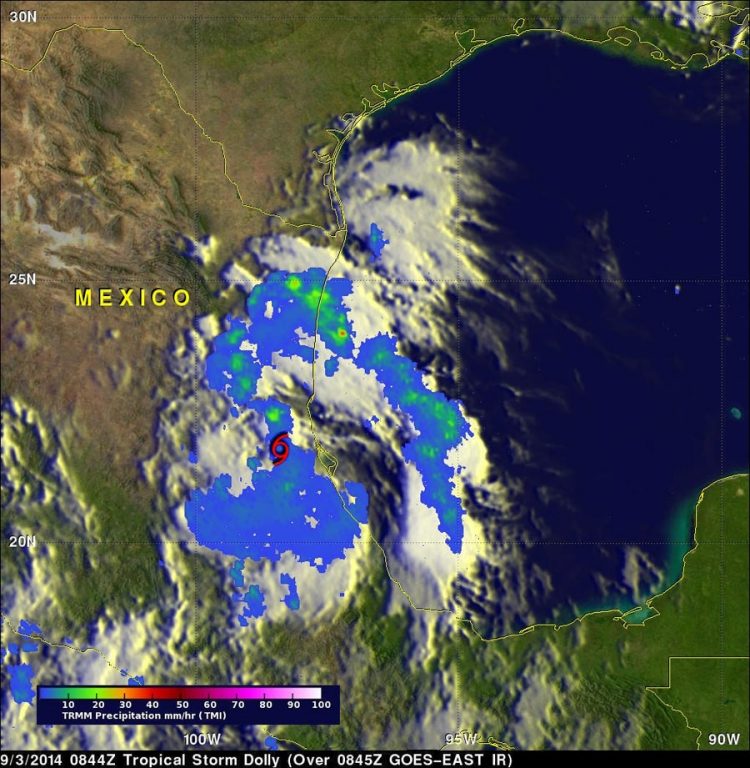NASA Sees Dolly's Remnants Bringing Showers to the Rio Grande Valley

NASA's TRMM satellite flew over Dolly on Sept. 3 at 3:33 a.m. CDT. Moderate to heavy rainfall, falling at a rate of over 1.2 inches per hour, was seen in a strong band of showers moving ashore north of Dolly's center. Image Credit: NASA/SSAI, Hal Pierce
NASA's Aqua satellite captured the remnants of Tropical Depression Dolly over northeastern Mexico on Sept. 3 at 19:40 UTC (3:40 p.m. EDT). The image, captured by the Moderate Resolution Imaging Spectroradiometer or MODIS instrument showed the center of Dolly over northeastern Mexico with a band of thunderstorms north of the center of circulation, spiraling over the Texas/Mexico border.
The Tropical Rainfall Measuring Mission or TRMM satellite flew over Tropical Storm Dolly early on September 3, 2014 at 0844 UTC (3:33 a.m. CDT). TRMM's Microwave Imager (TMI) collected with that orbit showed that Dolly was dropping light to moderate rainfall near the dissipating storm's center of circulation. Moderate to heavy rainfall, falling at a rate of over 30 mm (about 1.2 inches) per hour, was seen in a strong band of showers moving ashore north of Dolly's center.
The previous day, September 2, the TRMM satellite had a good daylight look at Dolly at 1616 UTC (11:16 a.m. CDT). At that time, strong north-northwesterly vertical shear was pushing powerful convective (rising air that condenses and forms thunderstorms) thunderstorms to the south of the tropical cyclone's center. Some of these storms were dropping rain at a rate of almost 83 mm (3.3 inches) per hour.
At NASA's Goddard Space Flight Center in Greenbelt, Maryland, that data was used to create a 3-D image that showed those intense storms. The data used to create the 3-D image was derived from TRMM's Precipitation Radar (PR) reflectivity data values. The 3-D image showed that some tops of these storms towered to heights of over 15km (about 9.3 km), indicating strong uplift of air.
The National Hurricane Center (NHC) issued the final advisory on Dolly on Wednesday, September 3 at 11 a.m. EDT (1500 UTC). At that time, Dolly had dissipated about 90 miles (145 km) west-southwest of Tampico, Mexico near 21.7 north latitude and 99.2 west longitude. At that time, Dolly's maximum sustained winds dropped to 30 mph (45 kph) and weakening quickly. It was moving to the west at 8 mph (13 kph).
Dolly's remnants are bringing rainfall to southern Texas today, September 4, 2014. The National Weather Service in Brownsville, Texas noted that low-to-mid-level moisture remains high across the Rio Grande Valley with the remnants of Tropical Depression Dolly across northeast Mexico. That moisture will trigger isolated and scattered thunderstorms across parts of the Valley today.
Rob Gutro
NASA's Goddard Space Flight Center, Greenbelt, Maryland
Media Contact
All latest news from the category: Earth Sciences
Earth Sciences (also referred to as Geosciences), which deals with basic issues surrounding our planet, plays a vital role in the area of energy and raw materials supply.
Earth Sciences comprises subjects such as geology, geography, geological informatics, paleontology, mineralogy, petrography, crystallography, geophysics, geodesy, glaciology, cartography, photogrammetry, meteorology and seismology, early-warning systems, earthquake research and polar research.
Newest articles

High-energy-density aqueous battery based on halogen multi-electron transfer
Traditional non-aqueous lithium-ion batteries have a high energy density, but their safety is compromised due to the flammable organic electrolytes they utilize. Aqueous batteries use water as the solvent for…

First-ever combined heart pump and pig kidney transplant
…gives new hope to patient with terminal illness. Surgeons at NYU Langone Health performed the first-ever combined mechanical heart pump and gene-edited pig kidney transplant surgery in a 54-year-old woman…

Biophysics: Testing how well biomarkers work
LMU researchers have developed a method to determine how reliably target proteins can be labeled using super-resolution fluorescence microscopy. Modern microscopy techniques make it possible to examine the inner workings…





















